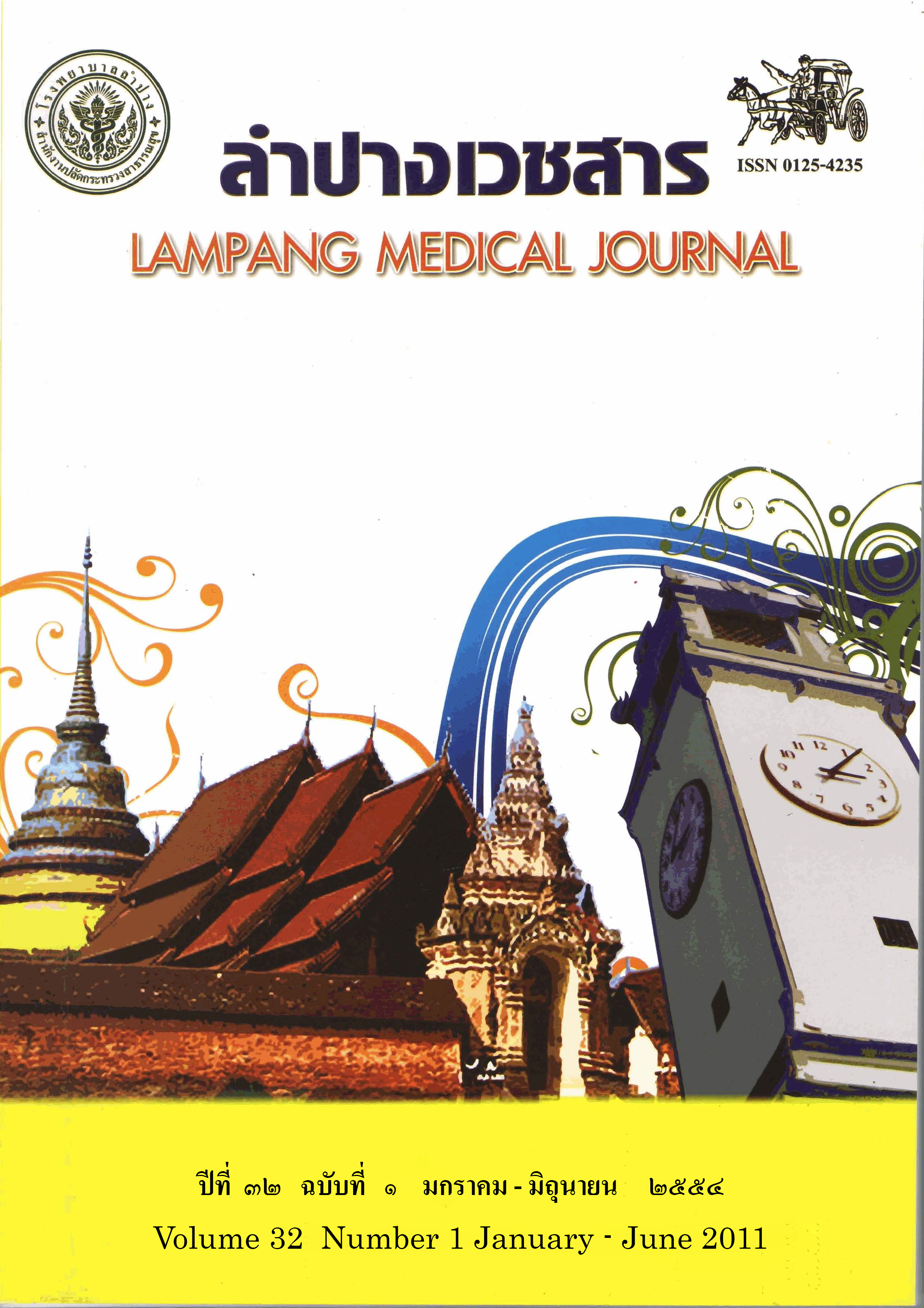Factors Influencing the Early Remission of Pediatric Thyrotoxicosis Within Two Years of Propylthiouracil Medication
Main Article Content
Abstract
Background : Propylthiouracil (PTU) is the anti-thyroid medication commonly used as a firstline therapy for pediatric thyrotoxicosis in Thailand. Because of low remission rate and long periods of medical therapy, several studies were attempted to identify factors associated with remission outcomes. These predicting factors remain controversial.
Objective : To evaluate predicting factors of early remission in pediatric thyrotoxicosis treated with PTU in Lampang Hospital.
Material and method : A cross-sectional analytical study was conducted on the patients age under 16 years who were diagnosed with thyrotoxicosis and treated with PTU at outpatient department of Lampang Hospital between 1st January 2002 and 28th February 2010. The general data, clinical findings, laboratory and treatment outcomes were retrospectively reviewed. The data was analyzed by descriptive statistics. Comparison between patients who achieved early remission within 2 years and who were treated for more than 2 years but did not achieve remission was analyzed by using student t-test and Fisher exact test. Odds ratio (OR) was
calculated to identify predicting factors by logistic regression analysis.
Results : Fifty-three patients enrolled the study (F:M = 43:10). The mean age was 11.1 ± 2.0 years. Twenty patients achieved remission with PTU within 2 years but thirty-three did not. Univariate analysis showed significantly less pulse pressure (p<0.001) and heart rate (p=0.04) in the remission group. Logistic regression analysis identified 4 predictors of early remission; smaller goiter size (OR=0.03, 95%CI 0.002-0.52, p=0.01), older age (OR=2.84, 95%CI 1.23- 6.54, p=0.01), narrow pulse pressure (OR=0.64, 95%CI 0.50-0.82, p<0.001) and low heart rate (OR=0.74, 95%CI 0.58-0.91, p=0.03). Adverse drug reactions of PTU were arthralgia (5%) and
skin rash (3%). No patient had major side effect.
Conclusion : Small goiter size, older age, narrow pulse pressure and low heart rate were predicting factors for remission of pediatric thyrotoxicosis within 2 years of PTU medication.
Article Details

This work is licensed under a Creative Commons Attribution-NonCommercial-NoDerivatives 4.0 International License.
บทความที่ส่งมาลงพิมพ์ต้องไม่เคยพิมพ์หรือกำลังได้รับการพิจารณาตีพิมพ์ในวารสารอื่น เนื้อหาในบทความต้องเป็นผลงานของผู้นิพนธ์เอง ไม่ได้ลอกเลียนหรือตัดทอนจากบทความอื่น โดยไม่ได้รับอนุญาตหรือไม่ได้อ้างอิงอย่างเหมาะสม การแก้ไขหรือให้ข้อมูลเพิ่มเติมแก่กองบรรณาธิการ จะต้องเสร็จสิ้นเป็นที่เรียบร้อยก่อนจะได้รับพิจารณาตีพิมพ์ และบทความที่ตีพิมพ์แล้วเป็นสมบัติ ของลำปางเวชสาร
References
มานะศรี อิศรางกูร ณ อยุธยา. ต่อมธัยรอยด์เป็นพิษ. ใน: ชวลิต ปรียาสมบัติ, เกศรา อัศดามงคล (บรรณาธิการ). โรคต่อมไร้ท่อในเด็ก (ฉบับพิเศษ). กรุงเทพฯ: สำนักพิมพ์ชัยเจริญ 2536. หน้า 90-3.
Dallas SJ, Foley PT. Hyperthyroidism. In : Lifshiz F, editor. Pediatric endocrinology. 3rd ed. New York: Marcel Dekker; 1996. p401-14.
Zimmerman D, Lteif NA. Thyrotoxicosis in chidren. Endocrine Metab Clin North Am 1998; 27: 109-20.
สัญชัย เชื้อสีห์แก้ว. โรคต่อมธัยรอยด์. ใน: สัญชัย เชื้อสีห์แก้ว (บรรณาธิการ). คู่มือโรคต่อมไร้ท่อในเด็ก. ฉบับพิมพ์ครั้งที่ 2. กรุงเทพฯ: นำอักษรการพิมพ์ 2538. หน้า 21-37.
Somnuke PH, Pusuwan P, Likitmaskul S, Santiprabhob J, Sawathiparnich P. Treatment outcome of Graves’ disease in Thai children. J Med Assoc Thai 2007; 90(9): 1815-9.
Jaruratanasirikul S, Leethanaporn K, Sriplung H. Thyrotoxicosis in children: treatment and outcome. J Med Assoc Thai 2006; 89(7): 967-73
Collen R, Landaw E, Kaplan S, Lippe B. Remission rates of children and adolescents with thyrotoxicosis treated with anti thyroid drugs. Pediatrics 1980; 65: 550-6.
Lippe B, Landaw E, Kaplan S. Hyperthyroidism in children treated with long term medical therapy : twenty-five percent remission every two years. J Clin Endocrinol Metab 1987; 64: 1241-5.
Glaser NS, Styne DM. Predictors of early remission of hyperthyroidism in children. J Clin Endocrinol Metab 1997; 82: 1719-26.
Garton C, Sodeghi NA, Senior B. Remission in children with hyperthyroidism treated with propylthiouracil. Am J Dis Child 1987; 141: 1084-6.
Buckingham B, Costin G, Roe T, Weitzman J, Kogut M. Hyperthyroidism in children. Am J Dis Child 1981; 135: 112-7.
Barnes H, Blizzard R. Antithyroid drug therapy for toxic diffuse goiter (Graves’ disease): thirty years experience in children and adolescents. J Pediatr 1977; 91(2): 313-20.
Winsa B, Dahlberg P, Jansson R, Agren H, Karlsson F. Factors influencing the outcomes of thyrostatic drug therapy in Graves’ disease. Acta Endocrinol (Copenh) 1990; 122: 722-8.
Clayton GW. Thyrotoxicosis in children. In: Kaplan SA, editor. Clinical pediatric and adolescent endocrinology. Philadelphia: W.B.Saunders; 1982. p110-7.
Schleusener H, Schwander J, Fischer C, Holle R, Holl G, Badenhoop K, et al. Prospective multi-centre study on the prediction of relapse after antithyroid drug treatment in patients with Graves’ disease. Acta Endocrinol (Copenh) 1989; 120: 689-701.
Bergman P, Auldist AW, Cameron F. Review of the outcome of management of Graves’ disease in children and adolescents. J Paediatr Child Health 2001; 37: 176-82.


